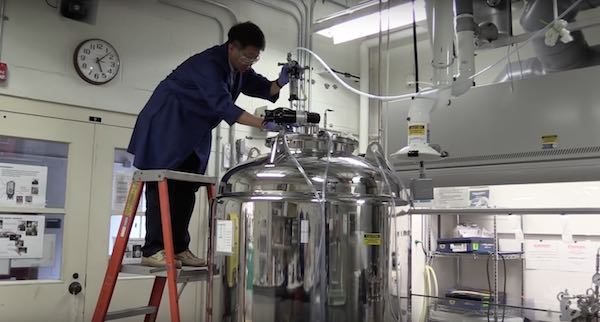
[Image above] Credit: Oak Ridge National Laboratory; YouTube
Quantum dots are lauded for their luminescent properties—which give the semiconducting nanoparticles the potential to improve various technologies, including displays, LEDs, and more.
When it comes to TV displays, for example, the narrow emission spectra of quantum dots allows them to create sharper, more vivid colors.
Despite their promising potential applications, however, many quantum dots are expensive to manufacture and often require use of toxic chemicals.
But they might not have to be limited much longer.
That’s because researchers at Oak Ridge National Lab (Oak Ridge, Tenn.) are going big when it comes to quantum dots.
ORNL scientists have developed a new process that turns to bacteria to do the hard work, harnessing them in giant reactors to manufacture zinc sulfide quantum dots via nanofermentation.
According to an ORNL press release, the team “used bacteria fed by inexpensive sugar at a temperature of 150ºF in 25- and 250-gallon reactors. Ultimately, the team produced about three-fourths of a pound of zinc sulfide nanoparticles—without process optimization, leaving room for even higher yields.”
And unlike other bacterial manufacturing techniques in which the product is produced within the cell walls, these bacteria extracellularly process the quantum dots, making it easy to collect and separate the nanoparticles from the bacteria themselves. According to the release, the process can reduce production costs by 90% as compared to more traditional manufacturing methods.
Plus, the technique is flexible. “Since biomanufacturing can control the quantum dot diameter, it is possible to produce a wide range of specifically tuned semiconducting nanomaterials, making them attractive for a variety of applications that include electronics, displays, solar cells, computer memory, energy storage, printed electronics, and bio-imaging,” ORNL team leader Ji-Won Moon adds in the press release.
In addition, the technique can stretch beyond quantum dots and could be used to produce magnetic, photovoltaic, catalytic, and phosphor materials as well.
According to the team, they sought to develop the greenest possible chemistry, and it looks like they’re well on their way to success.
Hear more from the Oak Ridge National Lab scientists themselves in the short video below.
Credit: Oak Ridge National Laboratory; YouTube
The paper describing the work is published in Biotechnological Products And Process Engineering—“Manufacturing demonstration of microbially mediated zinc sulfide nanoparticles in pilot-plant scale reactors” (DOI: 10.1007/s00253-016-7556-y).
